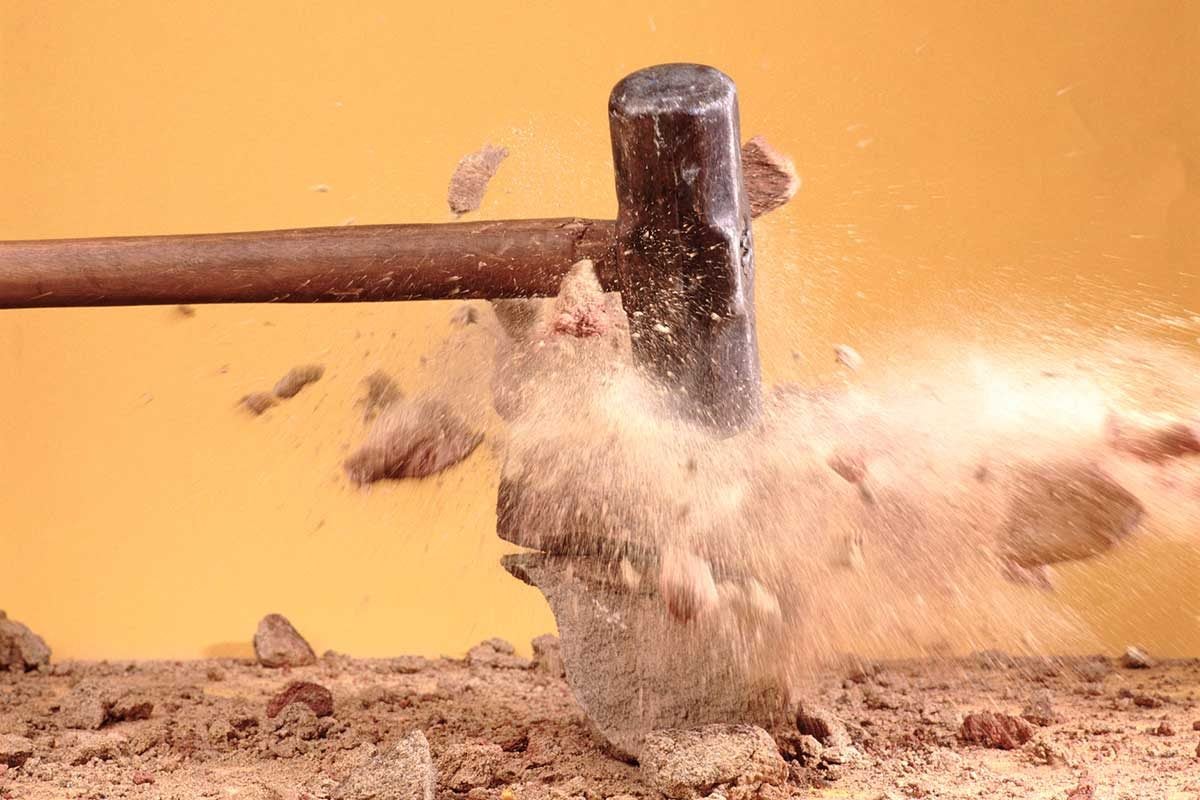If you plan on installing fences or doing serious renovation work, you'll definitely need a good sledge hammer. Here's what you need to know.

Sledge Hammers: What To Know Before You Buy

One of the simplest yet most versatile tools around, sledge hammers come in many shapes and sizes, but share a common purpose — striking an object, hard.
On This Page
What Is a Sledge Hammer?
Sledge hammers are large, long-handled striking tools designed to deliver as much blunt force as possible to an area or object. Much larger and heavier than hammers meant for driving nails, sledge hammers are most often used for demolition, or driving objects too thick and heavy to be driven with a regular hammer.
To be considered a true sledge hammer, it must have a straight handle, designed to be swung with two hands (although some smaller sledge hammers are short enough to be swung one-handed, if the user has sufficient arm strength). The heads of sledge hammers are almost always steel, typically flat on the striking face, and meant to deliver as much blunt force as possible to the target area.
Sledge Hammer Uses
Considering sledge hammers are such simple tools, they can be put to a surprising number of uses. On my homestead in rural Northern Ontario, Canada, sledge hammer use is a regular part of life. Here are some of the most common uses for sledge hammers:
- Demolition of drywall, concrete, wood, etc.;
- Driving steel wedges for splitting firewood or building stone;
- Dislodging firmly stuck items;
- Driving fence posts into the ground;
- Straightening bent metal objects.
Types of Sledge Hammers
Standard sledge hammer: Used for everything from demolishing unwanted walls during home renovation to driving steel wedges into logs to split firewood, standard sledge hammers are essential for every serious DIYer. They’re available in various lengths and handle weights, depending on the intended purpose. The longest, heaviest sledge hammers are more than three feet and can weigh up to 20 pounds. The smallest are around 18 inches in length and weigh two or three pounds. The heads of standard sledge hammers are cylindrical and flat or slightly rounded on both faces. Handles are usually hardwood, though carbon fiber is becoming more common.
Engineer’s hammer: Similar in look and feel to small standard sledge hammers, engineer’s hammers are 12 to 18 inches long with flat, rectangular heads weighing between two and six pounds. Short enough to be wielded with one or two hands, engineer’s hammers are ideal for light demolition work, driving small-to-medium-sized spikes into wood and striking steel chisels against stone or wood.
Post maul: Similar in appearance to large, long-handled standard sledge hammers, post maul sledge hammers are designed to drive fence posts and stakes deeply into the soil. Their cylindrical heads are usually larger in diameter than standard sledge hammers, with perfectly flat, circular faces designed to make striking accurately as easy as possible.
How to Choose a Sledge Hammer
To choose the right sledge hammer for you, begin by making a mental list of all the jobs you have in mind for the tool. Do you have big, heavy jobs that require lots of striking force? A long-handled, heavy sledgehammer is best for things like concrete and drywall demolition and driving fence posts. Smaller, lighter jobs take shorter, lighter hammers.
Another factor to consider is your upper body strength. Swinging a three-foot wooden handle with a 12-pound steel head takes lots of chest, shoulder and upper back strength. Proper swinging technique also means using your legs. Don’t overestimate your strength and end up with a hammer you can’t wield effectively.
By the same token, don’t choose a hammer that’s too light for the jobs you have in mind. It’s actually difficult to guess the right length and weight of hammer without trying a few. That’s why borrowing one from a friend, neighbor or family member before you buy makes sense. Try a few lengths and weights if possible, then make an informed decision.
How Much Do Sledge Hammers Cost?
Like length and weight, sledge hammer costs vary a lot. Expect to pay at least $30 for a small, short-handled hammer, and $200 or more for a long-handled model with a head eight pounds or heavier.
How to Use a Sledge Hammer
- Take a firm, two-handed grip on the bottom quarter of the handle, keeping your dominant hand above your non-dominant hand.
- Raise the hammer on the dominant side of your body.
- Keeping your elbows bent at approximately 90 degrees, bring the hammer down as hard as you can or need to, bending your knees as the hammer descends.
- Strike firmly and decisively, then reset and repeat as needed.
Sledge Hammer Maintenance
If your sledge hammer is one of the newer models with a carbon fiber handle, there’s not much you can or should do to maintain it. It’s built to last just fine on its own. Wooden-handled sledge hammers can be coated with boiled linseed oil once a season to keep the elements at bay.




















